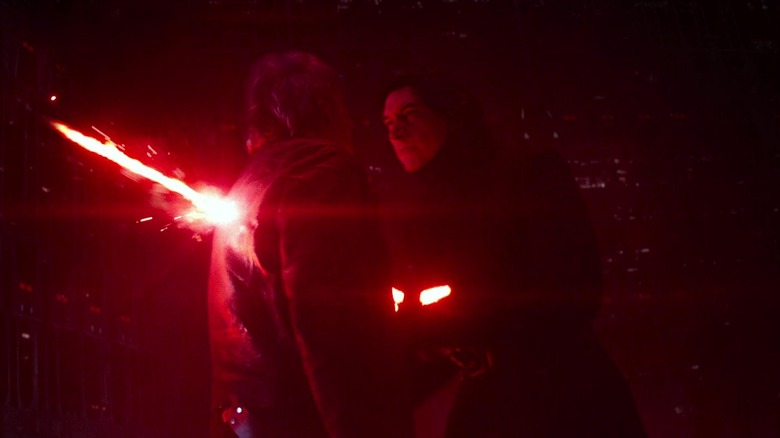Star Wars: What Would A Lightsaber Really Do To Your Body?
Out of all the iconic fantasy weapons that exist, from Mjölnir and the Master Sword to the Elder Wand and Keyblades, the lightsabers from "Star Wars" are probably the most beloved by their fanbase. After all, who doesn't want to wield a literal laser sword? They're the best! They're easily compactable for traveling purposes, they come in a variety of pretty colors, and they instantaneously inflict and cauterize wounds so that no one needs to see all the messy blood and gore that's piling up just beneath the vicious burns ... because that's what happens when a lightsaber comes into contact with flesh.
Sure, the "Star Wars" films exist inside a PG-13 framework that tends to obfuscate potentially traumatizing elements like body horror, but lightsabers are one of the few fantasy weapons that come with a built-in justification for easier viewing. Think about it. How often are lightsaber injuries hidden offscreen? Almost never. In "Ahsoka," Shin Hati (Ivanna Sakhno) stabs Sabine Wren (Natasha Liu Bordizzo) in the stomach, and that wound sizzles but never sprays viscera. In "Star Wars Episode VII: The Force Awakens," Rey Skywalker (Daisy Ridley) slashes Kylo Ren (Adam Driver) across the face, and in "Star Wars Episode IX: The Rise of Skywalker," she stabs him in the stomach — a popular spot, it seems, and both wounds are immediately sealed behind burns.
Most importantly, though, in "Star Wars Episode I: The Phantom Menace," Obi-Wan Kenobi (Ewan McGregor) slices Darth Maul (Ray Park) in half at the waist and there's only a brief spray at the moment of contact. And if that doesn't bleed profusely, then nothing will.
Lightsabers weren't designed with gore in mind
Now, it is true that some lightsaber wounds bleed because, in "Star Wars Episode IV: A New Hope," Obi-Wan Kenobi (Alec Guinness) defends Luke Skywalker (Mark Hamill) by removing the arm of a minor threat and the aforementioned limb bleeds profusely on the ground. Since this is technically the first lightsaber wound ever seen in "Star Wars," it's usually excused as existing before George Lucas really nailed down the finer details of what lightsabers could and couldn't do. In his defense, only so much exposition can fit inside a 13-page development essay, which he totally wrote.
In the beginning, the only thing that mattered to Lucas about the design of lightsabers was that they were symbolically civilized. He said as much during a featurette for the "Star Wars" YouTube channel. "In developing a group of peacekeepers ... I needed a weapon that was appropriate," he said. "It was more a symbol of a simpler time, of a time before the Empire had taken over — a time when honor ruled."
But just because honorable wounds don't bleed externally, it doesn't mean that they're necessarily cleaner or, at the very least, less gruesome. Some have theorized that the heat from a lightsaber would be so intense that not only would standing in the proximity of an unsheathed one cause instantaneous combustion but prolonged physical contact with the blade would explosively evaporate all the water molecules in one's body. Which, in a loose sense, explains the lack of blood from around lightsaber wounds. That's accounting for real-world science behind lightsabers, and who wants to do that? Us, we want to do that, because the Jedi's self-proclaimed elegant weapon of choice is steadily becoming a reality here on Earth.
Current lightsaber tech is way scarier than real lightsabers
Lightsabers are essentially glorified plasma cutters, and we've been using those for construction since at least the 1950s. Far more recently, however, ambitious geeks decided that it was high time we had laser swords. Hacksmith Industries, a YouTube-based engineering company whose sole purpose is to bring fictional tech to life, is at the point where they've built a lightsaber pike. If you don't know what a pike is, congratulations! You're not keyed into medieval warfare. It's like a spear but with a longer stabby bit at the end. This should both thrill and terrify you because, as the company notes, lightsaber pikes are canonically the last transitionary tech before we arrive at fully operational lightsabers.
Hacksmith Industries' current design does not ... cut cleanly. Its plasma blade melts and gouges and leaves a smoldering wreckage in its wake. The result of such a weapon coming into contact with a human body would be, in a word, devastating. The wound would not be localized, nor would it be so easily mended. The closest lore comparison is Kylo Ren's unstable lightsaber, the one that he uses to kill his own father ... and suddenly, the death of Han Solo (Harrison Ford) feels a whole lot darker, doesn't it?
Humanity is pretty great at inventing stuff that's super bad for itself. There's a non-zero chance that when, not if, lightsaber technology improves, scientists will receive a sudden and alarming dataset as to what laser swords are fully capable of inflicting upon the human body. Until such a time as that, let's just settle for the answers on Wookieepedia, shall we?


